




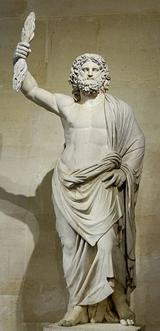






Artefact #1: Engraving of Zeus at Olympia- Philippe Galle.
This engraving of the Statue of Zeus at Olympia was made by Philippe Galle in 1572, obviously long after the time of the ancient Greeks. However, this depiction represents an incredibly important part of the history of Zeus. At Olympia, the site of the first Olympic Games and the present day location of the Olympic flame, there once stood a great temple dedicated to Zeus, and within it stood the great Statue of Zeus, as seen in Galle’s engraving. This statue was considered one of the Seven Wonders of the Ancient World. This artefact is incredibly interesting when examining one of Zeus’ particular roles in Greek society. Although Zeus did represent all of Greek Society, he was the god to whom the Olympic Games were dedicated. Competitors would compete for the glory of Zeus. We can see in this engraving, in the bottom right, two men wrestling at the foot of the statue. Wrestling was one of the key competitions in ancient Greek Olympics.
Though, the Olympics were not the only connection that this engraving depicts. We can also see many people in the act of worshipping before the great statue. As Zeus represented all of society and was the leader of the gods, he was arguably the primary figure of theology during that time period and was thus owed much respect.
The original statue of Zeus was crafted by Phidias in 432 BCE. It was made of ivory and gold-platted bronze. After the discovery of Phidias’ workshop in 1954, it was unearthed that the sculpture had used a description from Homer’s Iliad to design his magnificent work. The Statue is said to have remained in existence for 600 years after Phidias’ death. Everyone was encouraged to visit it at least once during their life, as it was considered a misfortune to die without seeing it.
Artefact #2: Statue of Zeus- Jupiter Smyrna
This is the Statue of Jupiter at Myrne (Jupiter being Zeus’ roman name) created in the 2nd Century and is a marble depiction of the god. It was discovered in 1680 and given to Louis the 14th, who had it restored at Zeus and forever more it has resided in France, today at the Louvre. There are some key points that should be noticed when examining this artefact. First, there is Zeus’ face, most specifically his beard. In all of the depictions of Zeus he has a large beard, which is meant to symbolize manliness. Unlike some of the other male gods, Apollo & Dionysus, historians have come to view Zeus as the head god because of his distinguishing male feature. Many of the other male gods were depicted as ‘boyish’, without beards. Zeus was meant to symbolize the paternal figure of the gods, which keenly reflected the paternal system of ancient Greece at that time.
His second distinguishing feature is the lighting bolt in his raised hand. In 1686 Pierre Garnier added the arm and lighting bolt to the statue, cementing it as a depiction of the Greek god. The Lighting Bolt was Zeus’ symbol, as the Trident was Poseidon’s. This helps us understand Zeus’ place as leader of the gods and ruler of the heavens. Lighting, which comes from the sky, indicates Zeus power and depicts his place in the heavens, ruler of the skies. Zeus role as chief deity seems unarguable, as his brothers (the other Elder male gods) Poseidon and Hades, hold sway over the Ocean and the Underworld. Zeus rules from the peak of Mount Olympus, high in the skies and in the heavens.
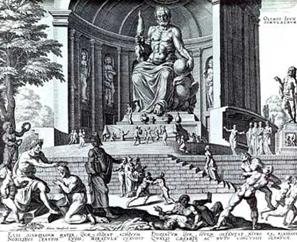










Artefact #3: Hades and Persephone in the underworld, interior of a red-figure cup, Greek, from Vulci, c. 430 BC
In this 5th century B.C. design from a red cup Hades is shown lounging with his unwilling consort Persephone while holding his cornucopia of plenty, a symbol of Hades’ wealth. The playwright Sophocles explains that "the gloomy Hades enriches himself with our sighs and our tears." This combination of wealth and fearsomeness mirrors the structure of Greek civilization. Though most polis were ruled with some form of democracy it was always the wealthy who held power, and control of life in the polis.
Another important element in this relic is the image of Persephone. Perhaps one of the most well known myths of Hades is the rape of Persephone. In this story Hades abducts Persephone, a daughter of Zeus and brings her to his realm. Her mother Demeter must plead with Zeus for his assistance in achieving Persephone’s return, even though it should be in Zeus’s interest as well. Zeus only has Hades release his daughter after Demeter places a curse on the land making it infertile. Zeus got Hades to release Persephone but because she had eaten 6 pomegranate seeds, she was to stay in the underworld for a set time of each year. Thus, Demeter once again makes the lands infertile during her daughter’s absence which the Greeks used to explain the different seasons. In Greek civilization as it is reflected in the Greek myths, parent child relationships were a far ways away from modern ideas of family. Often daughters would be married off for political gain, and sons would often struggle with fathers over power. Even Hades himself assisted Zeus in killing his own father, Cronos, so that Zeus and the Olympians could take power over the world.
Although characterized with a gloomy personality, feared by mortals and often in conflict with other gods, Hades was still revered in Greek society. The Greeks were no more comfortable with the afterlife than any other society, they honoured the dead and the fearful personality of Hades still had an important role in their society and myths.
Artefact #4: Hades Rape of Persephone
 This statue depicts one of the most well known myths of Hades, The Rape of Persephone. This story is portrayed in most instances where Hades is shown. In this story Hades abducts Persephone, a daughter of Zeus, while she is picking flowers and brings her to his realm. Her mother Demeter, the goddess of agriculture, grain, and bread, must plead with Zeus for his assistance in achieving Persephone’s return, even though it should be in Zeus’s interest as well. Zeus only has Hades release his daughter after Demeter places a curse on the land making it infertile; this would have caused humanity to die out unless Demeter blessed the land. In Greek civilization as it is reflected in the Greek myths, parent child relationships were a far ways away from modern ideas of family. Often daughters would be married off for political gain, and sons would often struggle with fathers over power. Even Hades himself assisted Zeus in killing his own father, Kronos, so that Zeus and the Olympians could take power over the world.
This statue depicts one of the most well known myths of Hades, The Rape of Persephone. This story is portrayed in most instances where Hades is shown. In this story Hades abducts Persephone, a daughter of Zeus, while she is picking flowers and brings her to his realm. Her mother Demeter, the goddess of agriculture, grain, and bread, must plead with Zeus for his assistance in achieving Persephone’s return, even though it should be in Zeus’s interest as well. Zeus only has Hades release his daughter after Demeter places a curse on the land making it infertile; this would have caused humanity to die out unless Demeter blessed the land. In Greek civilization as it is reflected in the Greek myths, parent child relationships were a far ways away from modern ideas of family. Often daughters would be married off for political gain, and sons would often struggle with fathers over power. Even Hades himself assisted Zeus in killing his own father, Kronos, so that Zeus and the Olympians could take power over the world.
 The Rape of Persephone is the Greeks explanation for the change in seasons. During her time in the underworld Hades tricks Persephone into eating pomegranate seeds which then bind her to return to the underworld for a portion of the year. During the time that Persephone is with Hades, Demeter refuses to bless the land and it withers away. This was the Greeks explanation for the seasons. While Persephone is with the gods on Mount Olympus, Demeter is happy and the season is Spring and Summer. When Persephone returns to the underworld Demeter grieves and the seasons change to fall and winter.
The Rape of Persephone is the Greeks explanation for the change in seasons. During her time in the underworld Hades tricks Persephone into eating pomegranate seeds which then bind her to return to the underworld for a portion of the year. During the time that Persephone is with Hades, Demeter refuses to bless the land and it withers away. This was the Greeks explanation for the seasons. While Persephone is with the gods on Mount Olympus, Demeter is happy and the season is Spring and Summer. When Persephone returns to the underworld Demeter grieves and the seasons change to fall and winter.
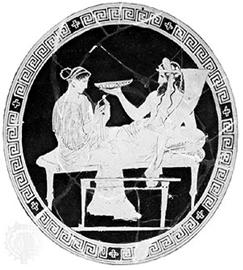

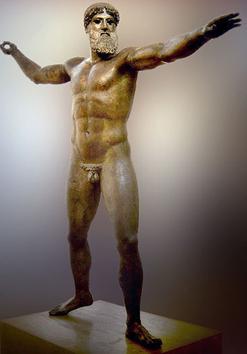
Artefact #5: “The Bronze statue from Artemision”
 This artifact is known as “The Bronze statue from Artemision”. This bronze sculpture is also recognized as the god recovered from the seabed of the Cape of Artemision in Northern Ionic Euboea. The sculptor of the statue has been yet to be identified, but Kalamis, Hageladas, an unknown Boeotian-Argive sculptor, and Myron have been suggested as possible sculptors[1]. The statue was discovered in 1926 and excavated in 1928; it was found in a shipwreck, this ship is believed to have sunk in the middle of the second century BCE. The bronze statue has a right hand that is raised above the extended left hand, as if it is ready to hurl something, the object about to be hurled is missing. There has been much debate as to who this god is, whether it is Zeus, the god of the sky or Poseidon the earth shaker and god of the ocean, because both gods strike the same pose when brandishing their iconic weapons. Zeus’s trademark weapon is his thunderbolt and Poseidon is represented holding a trident, which Homer in the Iliad says is used to stir up tides in the ocean. Poseidon exhibits an athletic stance of throwing a missing object in this bronze statue. Chris Karazous in his final publication of the statue recognized it unfailingly as a figure of Poseidon[2]. H.G Beyen also claimed that the statue is undeniably Poseidon, because by closely observing the statue it is evident that the whole in between the right hand only allows a narrow object to pass through[3]. The position and the distance of the right hand from the face justifies that the object being held by the statue was long in length and the position of the head shows that the god is trying to get a clear view and is measuring his target. Julius Juthner has claimed that the statue is indeed not a god, but an athlete who was successful in the pentathlon (A contest of the Greek people that featured five events)[4]. This statue is the source of various debates, which can all be answered by the recovery of the missing item, but seeking the missing item was abandoned, because of the dangers of the searching the shipwreck which led to a death of one of the divers. One of the arguments used to prove that the statue is a god, is the size of the statue, it is 208 centimeters, equivalent to 6 feet and 8 inches. The size of the object allows us to understand the way the early Greeks reflected the greatness of their gods, by illustrating their magnificence in sculptures[5]. Juthner argues that also athletes in the early Greece were anointed divine status and the statue could represent an athlete in his prime, but the beard disagrees with his ideology, because most athletes in their prime were young and beardless and the Greeks were not naturalistic to capture beards in the statues of a man[6]. The statue of the god Poseidon exemplifies the Greek notion of arête meaning goodness; success; knowledge and virtue in all that individuals do to achieve full potential. So from the statue we understand that the Greeks acknowledged athletes and represented them in god like image. The stance of the god depicted above is still used in athletics, especially the tossing of a javelin. As the sculpture is represented we can relate the beard as a source of wisdom and knowledge and the body as athletic perfection.
This artifact is known as “The Bronze statue from Artemision”. This bronze sculpture is also recognized as the god recovered from the seabed of the Cape of Artemision in Northern Ionic Euboea. The sculptor of the statue has been yet to be identified, but Kalamis, Hageladas, an unknown Boeotian-Argive sculptor, and Myron have been suggested as possible sculptors[1]. The statue was discovered in 1926 and excavated in 1928; it was found in a shipwreck, this ship is believed to have sunk in the middle of the second century BCE. The bronze statue has a right hand that is raised above the extended left hand, as if it is ready to hurl something, the object about to be hurled is missing. There has been much debate as to who this god is, whether it is Zeus, the god of the sky or Poseidon the earth shaker and god of the ocean, because both gods strike the same pose when brandishing their iconic weapons. Zeus’s trademark weapon is his thunderbolt and Poseidon is represented holding a trident, which Homer in the Iliad says is used to stir up tides in the ocean. Poseidon exhibits an athletic stance of throwing a missing object in this bronze statue. Chris Karazous in his final publication of the statue recognized it unfailingly as a figure of Poseidon[2]. H.G Beyen also claimed that the statue is undeniably Poseidon, because by closely observing the statue it is evident that the whole in between the right hand only allows a narrow object to pass through[3]. The position and the distance of the right hand from the face justifies that the object being held by the statue was long in length and the position of the head shows that the god is trying to get a clear view and is measuring his target. Julius Juthner has claimed that the statue is indeed not a god, but an athlete who was successful in the pentathlon (A contest of the Greek people that featured five events)[4]. This statue is the source of various debates, which can all be answered by the recovery of the missing item, but seeking the missing item was abandoned, because of the dangers of the searching the shipwreck which led to a death of one of the divers. One of the arguments used to prove that the statue is a god, is the size of the statue, it is 208 centimeters, equivalent to 6 feet and 8 inches. The size of the object allows us to understand the way the early Greeks reflected the greatness of their gods, by illustrating their magnificence in sculptures[5]. Juthner argues that also athletes in the early Greece were anointed divine status and the statue could represent an athlete in his prime, but the beard disagrees with his ideology, because most athletes in their prime were young and beardless and the Greeks were not naturalistic to capture beards in the statues of a man[6]. The statue of the god Poseidon exemplifies the Greek notion of arête meaning goodness; success; knowledge and virtue in all that individuals do to achieve full potential. So from the statue we understand that the Greeks acknowledged athletes and represented them in god like image. The stance of the god depicted above is still used in athletics, especially the tossing of a javelin. As the sculpture is represented we can relate the beard as a source of wisdom and knowledge and the body as athletic perfection.
Artefact #6: Ancient Macedonian coin
 This Artifact is of significant value to the historical representation of Greek culture. This Artifact is an ancient Macedonian coin depicting the face of Demetrius Poliorcetes and the image of Poseidon the god of the sea[7]. The image shows Poseidon holding a trident with his left hand and his right foot planted on a rock. Poseidon image is used to show superiority as he wields his trident as a method of stamping his authority as lord of the seas. This silver coin was developed around 301-283BC, and was one of Demetrius Poliorcretes exhibition of power. He assumed naval supremacy from the Egyptian kings of the southern Mediterranean. The image on the coin is constructed in relief form, one of the major methods of art to the early Egyptians, so the image on the coin tells us that the Greeks adopted drawing and sculpting techniques from the Egyptians. Following the death of his father, Demetrius became sole ruler and begun to issue out coins in his own name as a representation of his dominance of power. The writing on the coin ΒΑΣΙΛΕΩΣ ΔΗΜΗΤΡΙΟΥ represents the coin of King Demetrius[8]. Obtaining control of the Mediterranean was important in Early Greek times, because it was the major source of transportation and trades to other polis. The image of Poseidon at the back of the coin show the Macedonian kings boast of naval supremacy in the Mediterranean. His kingdom stretched from Greece to Macedonia to Cyprus by the way of the Asia Minor[9]. The sea was the ruling domain of the king and he used the image of Poseidon to demonstrate his power and acknowledge himself as the king of the ocean, the image can be analyzed as him being ordained by Poseidon to be the emperor of the seas, so from this coin it should be recognized that the image of the gods are used as a method of propaganda. The Macedonian king used the coin as the image of Poseidon as a representation and constant reminder of his superiority. The king uses the coin to constantly show that his power is equivalent to that of a god and therefore he should be treated, feared and respected like one.
This Artifact is of significant value to the historical representation of Greek culture. This Artifact is an ancient Macedonian coin depicting the face of Demetrius Poliorcetes and the image of Poseidon the god of the sea[7]. The image shows Poseidon holding a trident with his left hand and his right foot planted on a rock. Poseidon image is used to show superiority as he wields his trident as a method of stamping his authority as lord of the seas. This silver coin was developed around 301-283BC, and was one of Demetrius Poliorcretes exhibition of power. He assumed naval supremacy from the Egyptian kings of the southern Mediterranean. The image on the coin is constructed in relief form, one of the major methods of art to the early Egyptians, so the image on the coin tells us that the Greeks adopted drawing and sculpting techniques from the Egyptians. Following the death of his father, Demetrius became sole ruler and begun to issue out coins in his own name as a representation of his dominance of power. The writing on the coin ΒΑΣΙΛΕΩΣ ΔΗΜΗΤΡΙΟΥ represents the coin of King Demetrius[8]. Obtaining control of the Mediterranean was important in Early Greek times, because it was the major source of transportation and trades to other polis. The image of Poseidon at the back of the coin show the Macedonian kings boast of naval supremacy in the Mediterranean. His kingdom stretched from Greece to Macedonia to Cyprus by the way of the Asia Minor[9]. The sea was the ruling domain of the king and he used the image of Poseidon to demonstrate his power and acknowledge himself as the king of the ocean, the image can be analyzed as him being ordained by Poseidon to be the emperor of the seas, so from this coin it should be recognized that the image of the gods are used as a method of propaganda. The Macedonian king used the coin as the image of Poseidon as a representation and constant reminder of his superiority. The king uses the coin to constantly show that his power is equivalent to that of a god and therefore he should be treated, feared and respected like one.

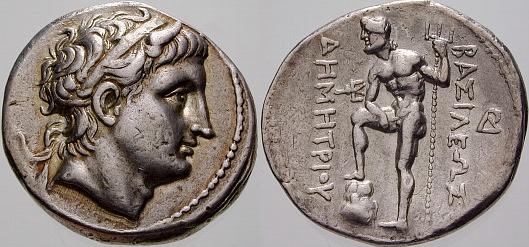
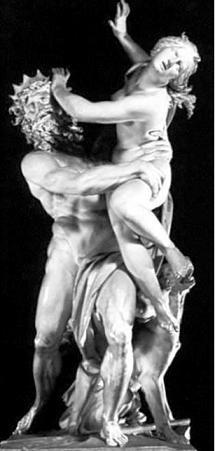
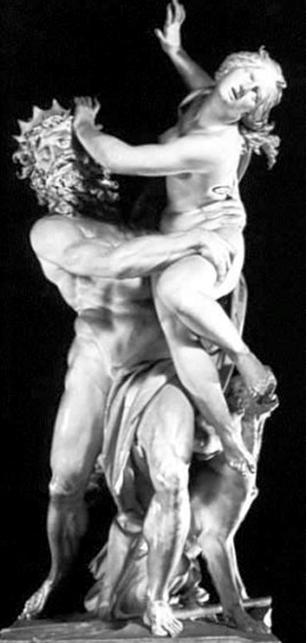
HIST 1001B - Mike MacGowan 100687581, Jeremy Roberts 100811513, Jeff Mackey 100806580, Tope Adekola 100798519, Billy O'Reilly 100798902











